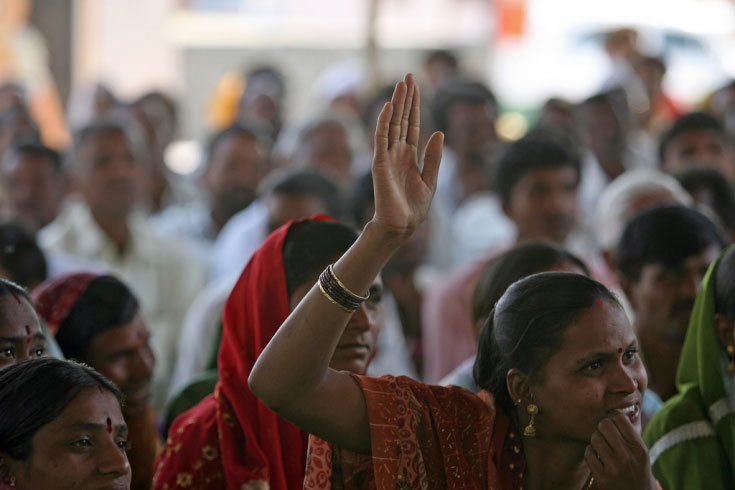Jordan River Foundation: IMAGINE Empowerment Workshop Evaluation Results
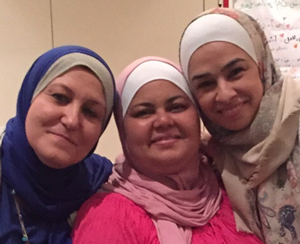 Introduction
Introduction
Jordan River Foundation (JRF) conducted a series of Empowerment Workshops as part of the IMAGINE initiative targeting a group of its program’s female beneficiaries. This report presents the workshops impact evaluation results. The results were drawn from a representative sample, whose members’ input was surveyed to explore the impact the training had on its participants’ lives.
Since 2012, JRF has committed itself to offer its beneficiaries the training. The trainings are implemented at the Foundations’ local partners’ headquarters across the Kingdom.
The Empowerment Workshop enhances a woman’s self knowledge and deepens her inner identity enabling her to tackle the multifaceted challenges she faces. It does this by helping her learn how to dream and realize these dreams for her life. Specifically the workshop helps her do this in seven areas of life: emotions, relationships. sexuality, her body, money, work and spirituality .
The following table illustrates the approximate number of the female workshop participants enrolled in the Empowerment Workshop since 2012 from across the Kingdom:
Table 1: # of Women Participating in the Empowerment Workshop in Jordan
| Governorate | # of Trainees |
| Amman | 273 |
| Al-Aqaba | 44 |
| Ma’an | 23 |
| Al-Karak | 35 |
| Jerash | 100 |
| Al-Mafraq | 71 |
| Irbid | 34 |
| Total | 580 |
A group of JRF trainers certified by Empowerment Institute, a partner based in The US who has developed the Empowerment Workshop, conducted this training. For the purposes of evaluating the impact of the Empowerment Workshop on the participants over the past three years, the Evaluation Team conducted several activities illustrated by the following diagram:
Diagram 1: Evaluation Team Activities

Subsequently, the Evaluation Team coordinated with JRF’s partners to invite back the trainees, including the partner organizations.’ Over several days, the meetings took place and trainees’ feedback and reactions pertaining the training was obtained.
2. Evaluation Methodology
2.1 Evaluation Form: Development, Revision and Approval
The Evaluation Team developed an evaluation form unique to the Empowerment Training. The team shared the form with the trainers for feedback before the final draft was ready. The form comprised of five parts:
First: Basic Information
Second: Training General Inquiries
Third: Training Material, Trainers, Training Location
Fourth: Training Outputs
Fifth: Follow-up
2.2 Representative Sample Selection, Visits Schedule
Subsequently, 20% of the training participants were randomly selected as sample for conducting the training evaluation, the random sample included a total of 116 participants. To guarantee fairness, the same percentage, 20%, was applied to the trainers to determine the number of women to be interviewed from each trained group. Accordingly, the trainers were informed of the number of women they need to participate; in turn the trainers coordinated with the associations and the beneficiaries to inform them of the evaluation.
The Evaluation Team coordinated with the Partners to invite the beneficiaries to attend the evaluation meetings, schedule the evaluation sessions and venues. Annex (2) includes the visits schedule.
2.3 Data Collection
The Evaluation Team conducted individual meetings with each beneficiary to gather the required data at the partner organizations and Foundation centers.
The following diagram details the numbers of respondents during the evaluation process. The total number of respondents was 109, though the original sample size specified was 116. This difference resulted from the fact that the team faced difficulties in connecting with a number of women, as a result of contact information changes (phone numbers, addresses), or due to their inability to attend the meetings. The respondents came from Amman, Jerash, Al-Mafraq, Al-Karak, and Aqaba, as follows:
Diagram 2: Number of Evaluation Respondents
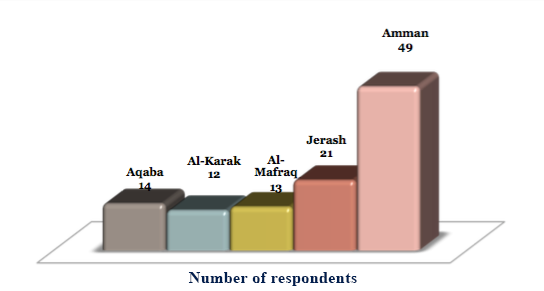
3. Evaluation Results Analysis
3.1 Basic Information
Diagram 3: Age Groups
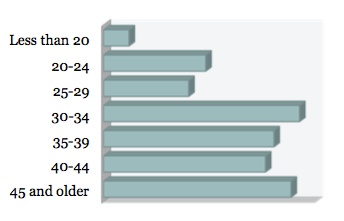
Respondents’ age groups were divided as follows: 39 percent of respondents were in the age group 30-39. 2 percent of the women interviewed were under 20 years, which is the lowest participants’ percentage.
Diagram 4: Nationality
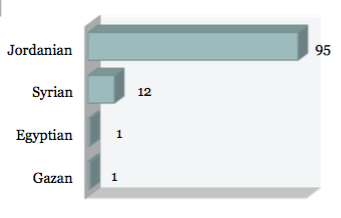
Pertaining to nationalities, 87 percent of the respondents were Jordanian, followed by Syrian nationals, with a percentage of 11 percent. Other nationalities split the remaining percentage.
Diagram 5: Social Status

60 percent of the respondents were married women, who constituted the highest percentage across the sample.
Diagram 6: Educational Level

Under education, women who completed their highschool education constituted a majority; they were 38 women in total.
Diagram 7: Employment
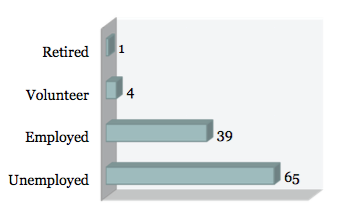
Pertaining to employment, the number of unemployed women was 65.
Diagram 8: Date of Training Enrollment
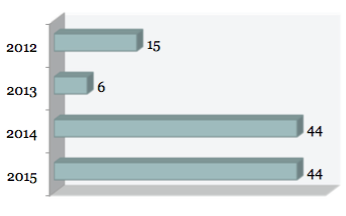
The evaluation showed that 44 women enrolled in the training in 2015 and 44 enrolled in 2014.
3.2 Training General Inquiries
Diagram 9: Number of Attendance Days
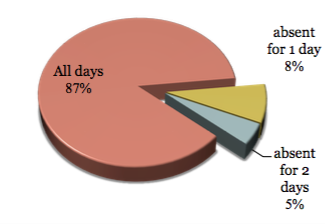
The percentage of respondents who attended all training days was 87 percent, 8 percent of respondents were absent for one day, and only 5 percent were absent for two days, as illustrated in the diagram. The respondents who were absent expressed their interest in attending future training.
95 percent of respondents they were compelled to attend by the training material.
Pertaining to the training effect on the personal lives of its attendees, 71percent of respondents shared they were witnessing changes taking place in their lives. For instance, a respondent who was a Syrian refugee shared that when she first arrived in Jordan she was introverted and feared leaving her house or dealing with people, a result of witnessing the events in her country on the one hand, and on the other the change in the society around her. However, she pointed out that attending the training left its impact on her life, as she started to go out shopping and she sought forming friendships and connections with her neighbors and participating in the community. 29 percent pointed out that their lives were relatively affected. Overall, the results indicate that the training had positive effects on the personal lives of beneficiaries, as illustrated in the following diagram.
Diagram 10: Training Influence on the Personal Lives of Participants
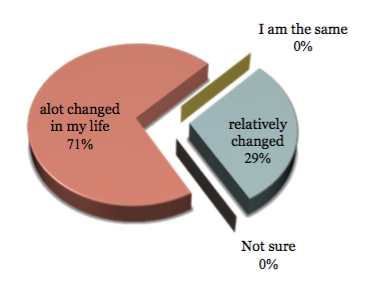
Table 2: Life Aspects Most Impacted by the Training
| Strength of character | 63% |
| Relationships | 46% |
| Emotions | 37% |
| Physical wellness/Health | 34% |
| From Complaining to Seeing | 28% |
| Work | 23% |
| Spirituality | 21% |
| Basic Beliefs | 18% |
| Sex/ Feelings | 10% |
| Money | 9% |
Pertaining to the training components that the respondents considered most influential on their personal lives, each respondent defined three components that had the most effect on her life; 63 percent considered strength of character to be the most significant. For example, one participant related that before taking the training she could not face her husband when he took a decision related to their family. After the training, she gradually participated in making decisions, as well as developed the ability to persuade him when they did not see eye-to-eye. Ranking next was the relationships component with 46 percent thought the training helped trainees form friendships within and beyond the training, and generally improved their relationships with others.
“The way I dress changed, I now wear colors” beneficiary from Jerash
“I exercise in the street despite the initial disapproval of the neighborhood, they are coming around now” beneficiary from Jerash
“The training played a positive role in making my husband and family accept change” beneficiary from Amman/ Jabal Al-Nasr
Table 3: Life Aspects Least Impacted by Training
Money | 45% |
Work | 39% |
39Sex/Feelings | 34% |
Spirituality | 29% |
Physical Wellness/Health | 21% |
Basic Beliefs | 20% |
From Complaining to Vision | 14% |
Emotions | 14% |
Relationships | 14% |
Strength of Character | 6% |
Table 4: Training Features
| Training material | 52% |
| Trainers’ method | 43% |
| Family/ comforting atmosphere | 27% |
| Pertaining to one’s self | 26% |
| Confidentiality/ Discretion | 11% |
| Stress Relief | 9% |
Table 4 lists the training features the respondents considered compellig for them to commit to attending the training. According to the data 52, percent of respondents considered the training to be different from other trainings they attended, especially pertaining to the training tools, as well as to the nature of the material that spoke to the reality lived by many participants. 43 percent of the respondents pointed out that the trainers’ method was key quality that helped them relax into sharing their own experiences with the trainers and trainees at the same time.
The comfortable friendly atmosphere among the groups during the training was recongized by 27 percent of the respondents. In addtion, 26 percent of the respondents expressed that their satisfaction with the training came from the fact that it encouraged self-expression, as opposed to other types of training that focused on developing work or family relations or raising children. Furthermore, 11 percent of the respondents praised the discretion the trainers and trainees committed themselves to. In this regard, it is worthy to point out that the JRF trainers use taking an oath as a tool to protect the confidentiality of participants, which created the necessary ease to discuss different topics.

3.3 Trainers and Content Evaluation
First: Trainers’ Evaluation
The following diagram illustrates the trainers’ evaluation according to the respondents who were interviewed.
Diagram 11: Trainers’ Evaluation
The diagram above reveals the following:
- The respondents expressed very strong approval with the Empowerment trainers’ performance, as indicated by the substantial number of participants who selected “Excellent” in the trainers’ evaluation section. The remaining participants’ responses varied between “very good” and “good”, none selected “medium” or “weak” as a response.
- Many participants praised the trainers’ for shifting from using traditional approaches of “instructing about various topics in a classroom like setting” to “facilitating personal development through a dynamic group process” as a training method.
“The training was like magic and the trainer a magic wand” Beneficiary from Al-Karak
“The trainer created bridges of trust between us; we felt comfortable discussing different private topics” Beneficiary from Amman, Jabal Al-Nasr
“The trainer changed my life, I was ready to take my own life, but now I’m alive and I want to volunteer and help others”Beneficiary from Al-Mafraq
A woman from Al-Mafraq held neither diploma nor income-generating occupation. She sought employment to no avail, and she considered starting her own business. But her lack of self-confidence usually stood between her and her dream.
Before the Empowerment Workshop, she had the opportunity to enroll in the Emergency Employment Project, offered as part of JRF’s Social Empowerment Program. Despite the great encouragement she received, she did not have sufficient positive attitude to engage. After the Empowerment Workshop, she developed the necessary confidence to decide to enroll in the project, which was her first decision upon completing the training. This type of experience has occurred consistently and convinced JRF to use the Empowerment Workshop’s agency creating ability as a perquisite to its other more resource oriented trainings.
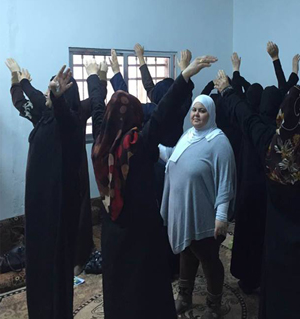
Second: Training Content Evaluation
The training content evaluation revealed the following results:
- The participants had great appreciation for the training content with an average score of 92%.
- They appreciated how different it was different from other trainings for its focus on the “self”.
- The training content varied between trainers, which reflected that the Training and Consultations Sector did not adopt a standardized training material for the Empowerment Training.
- Some exercises presented during the training were literally translated from English to Arabic, which caused some women to face difficulties in understanding the exercises; they needed to contemplate the words to try to understand their jest, in addition to asking the trainers for clarifications.
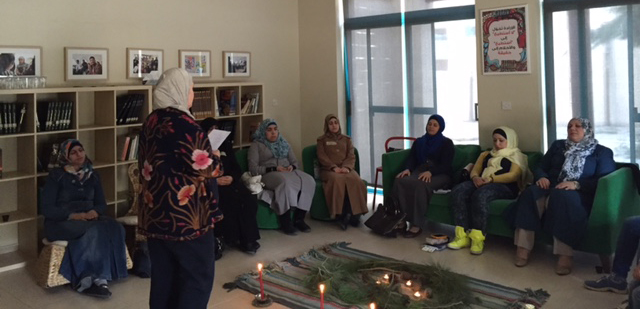
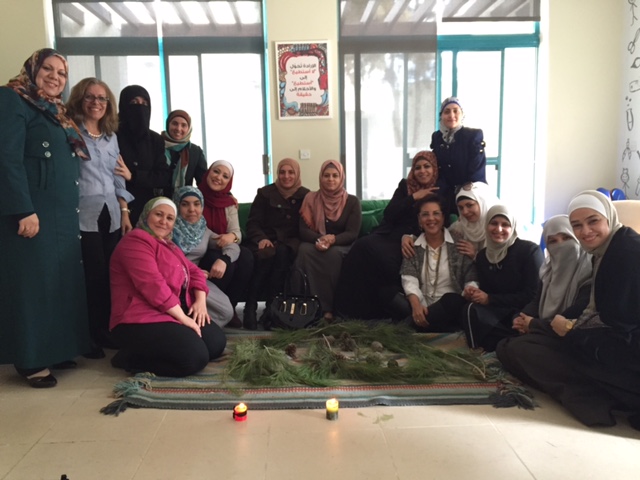
Diagram 12: Training Content Evaluation
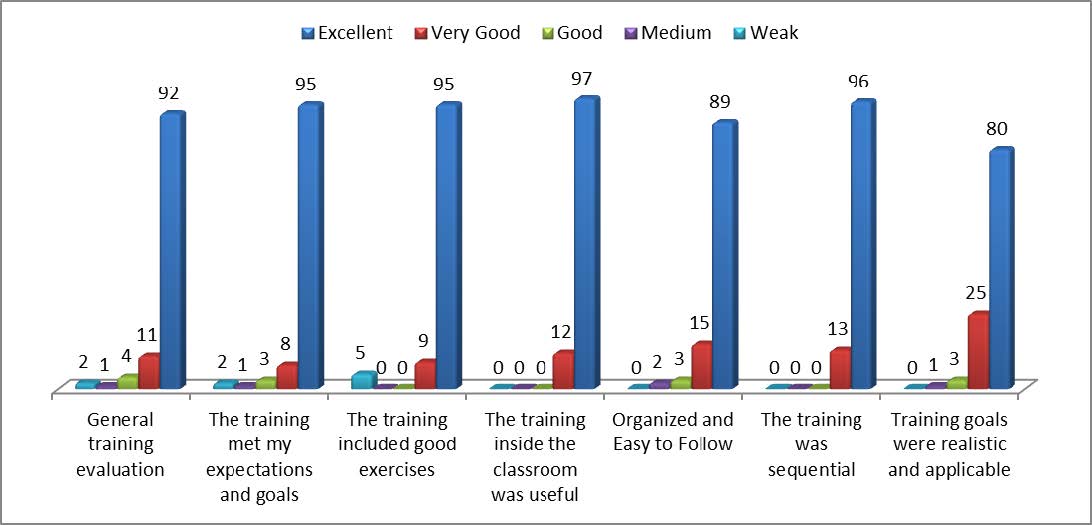
In addition to previous results, the following was revealed:
- The majority of participants enjoyed the diverse and fun activities, such as relaxation, dance, and music.
- The majority of participants felt that sharing experiences during the training was useful.
- The participants kept their notebooks from the training which assisted each of them in solving her problems, which sustained the impact of the training.
- The participants expressed their feeling that the training needs to have longer duration, as many of them had no prior knowledge pertaining to the content of the training. A group of participants expressed their need to repeat the training to maximize their results.
- The trainers played a key role in introducing ways that cater to the prevalent beliefs.
“The training deepened my knowledge of myself; I’m more daring and at ease” Beneficiary from Aqaba
“I consider myself a success story empowered by the Self-Empowerment Training” Beneficiary from Aqaba
“The training introduced me to things that were unknown to me” Beneficiary from Amman, Jabal Al-Nasr
Third: Venue Evaluation
The evaluation of training venue and timing revealed that the respondents were generally satisfied with the timing of the trainings, as well as the venues.
Diagram 13: Venue and Timing Evaluation
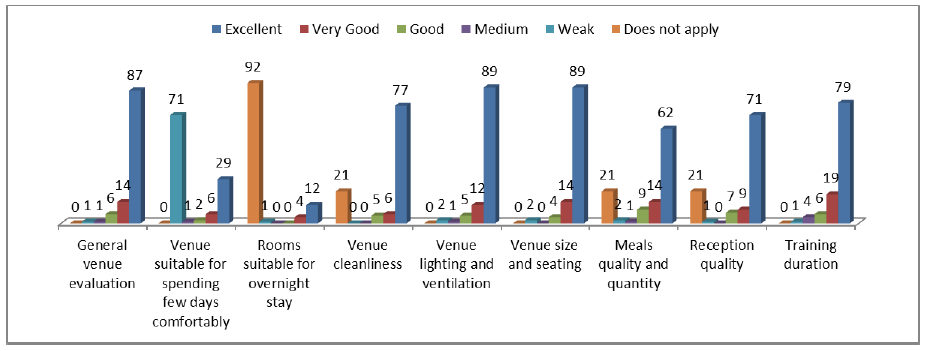
The results of the evaluation pertaining to the training venue and timing revealed the following points:
- Most respondents expressed the need to continue the work either through a new training or individual sessions.
- The respondents had no reservations to the training venues, which were located in the headquarters of the associations offering JRF’s services, in addition to the Queen Rania Center in Jabal Al-Nasr, Karma Center in Jabal Al-Natheef, as well as a Dead Sea Hotel. One respondent group who were employees at Karma Center, however, expressed some reservations against holding the training at their workplace, since they were interrupted during the sessions to follow up some duties, which affected their concentration and commitment to the training.
- It was pointed out that the training could have been nicer had it been offered in remote places such as Northern Forests or Wadi Rum.
“I looked forward to every new day to find out what I’ll be learning” A beneficiary from Al-Mafraq
“Training was fun, and going to the sea was a nice change in view” A Beneficiary from Aqaba
“We were transported to a different world during the training, we danced and heard music, that was very lovely” A Beneficiary from Al-Mafraq
3.4 Training Impact
Questions were created to evaluate the training impact on the personal lives of participants. The 19 questions averaged a 90% good to excellent rating. The top five questions were: getting rid of misconceptions that had power over me – 96%, thinking of different ways to get what I want – 96%, taking better care of myself – 95%, increase in self confidence – 94%, and having more choices to solve my problems – 92%.
Table 5: Training Impact
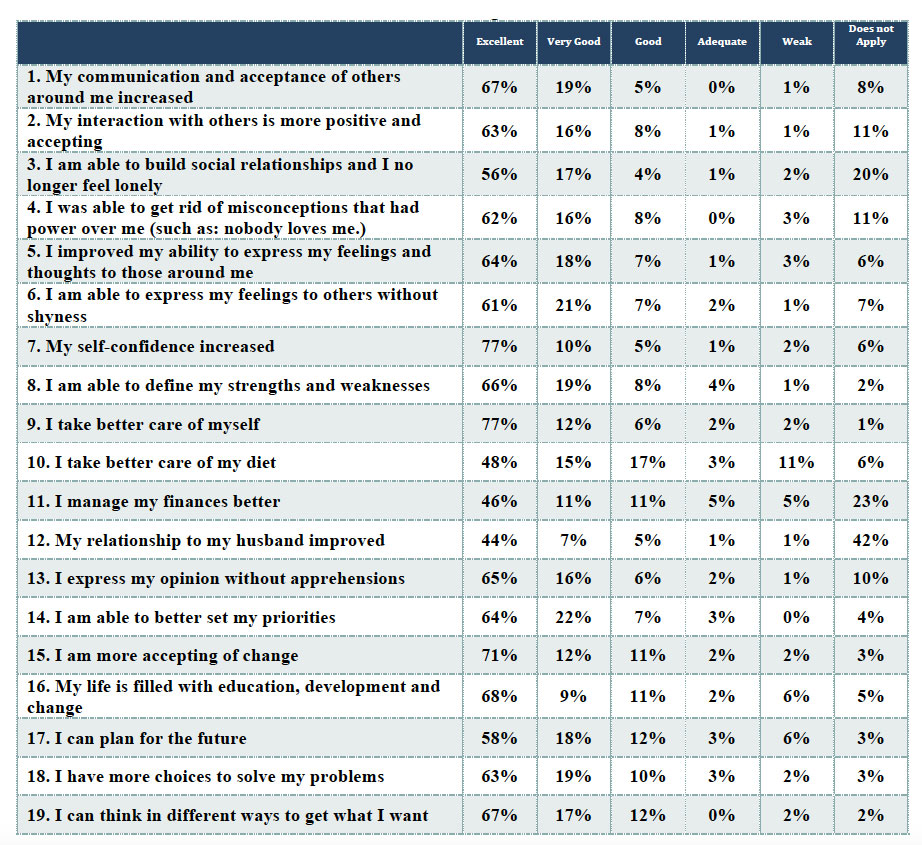
Follow-up
Upon asking the respondents about post-training follow-up among trainees in particular, and between the trainers and trainees in general, the following results were revealed:
Diagram 14: Post-training Follow-up Evaluation

The following points summarize the beneficiaries’ feedback:
- Most participants continue to follow up with each other, which is facilitated by smartphone apps.
- There is a need to hold periodic meetings for a group of beneficiaries to discuss developments to their problems, and propose new solutions.
- In general, the beneficiaries are not connecting with the trainers; however, the Queen Rania Center’s beneficiaries who received their training at the Center are able to connect with a number of their trainers who work at the Center.
- Some trainees requested follow-up sessions with the trainers, either through holding new training courses or regular group meetings.
- The trainers consider the lack of follow-up a positive aspect, since they empowered their trainees who become aware of how to handle their own concerns.
4. Success Stories
Alaa’ Kreishan says: “The training I received on Self-Empowerment changed my life … I am stronger … I seize opportunities, I think positively and solve my own problems”, she adds “my relationship to others has improved”
Alaa’ Kreshan was one of 600 women across the Kingdom who received Empowerment Workshop offered by the Jordan River Foundation.
Alaa’ has been a diabetic since childhood, which had its effect on her life socially and psychologically. Because of her illness, she shied away from people, and believed that due to her condition she would not get married; she lived in optional isolation until she accidentally became aware of training on self-empowerment. She was encouraged to enroll in the all-female training. The training helped Alaa’ overcome her years-long solitude; she met many people during the training, and became aware that many lived and adjusted to a life with diabetes. Later she saw a doctor to treat her condition and learn ways to manage it. Today she leads a normal life and has formed many friendships.
Another beneficiary, Maryam, is a Syrian refugee in Jordan. She enrolled in the Empowerment Workshop in Jerash. She says: “I became more engaged with the Jordanian community; I shop and seek to form new friendships”. In the early days after displacement, Maryam became introverted as a result of witnessing the strife in Syria, in addition to living in a different community. Now she feels pleased with attending the Self-Empowerment training, mainly because she depends on the skills she acquired during the training.
I am able to better set my priorities
 Azhar –Al-Karak Governorate – 24 Years
Azhar –Al-Karak Governorate – 24 Years
After completing her studies at university, and obtaining her Bachelor degree, Azhar was unable to convince her parents to return to school for advanced studies or seek employment, and they almost forced her into marriage. When she joined the Self-Empowerment training, she became aware that she can pursue higher education and get married without detriment to her ambition. The training gave her a group of ideas to earn an income; consequently she found employment, the income of which helped her pay for her tuition. She was able to convince her parents to contribute to her tuition as well.
“Azhar now prepares for her Master’s Dissertation, with support from her parents”
My self-confidence increased
 Lubna – Aqaba Governorate – 37 years
Lubna – Aqaba Governorate – 37 years
Lubna always wanted to own her own women beauty parlor, but her lack of self-confidence prevented her from attaining her dream. Being a mother, she doubted she could balance the responsibilities of work and child-caring. When she enrolled in the Self-Empowerment training, she overcame such beliefs and was able to open her dream beauty parlor within a week from taking the training. Her step had no negative effects on her relationship with her children; rather they improved their school performance.
My interaction with others is more positive and accepting
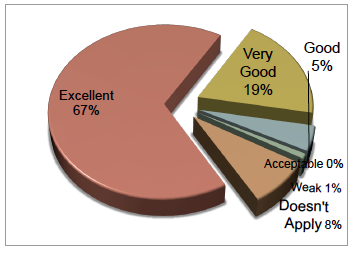 Huda- Al-Karak Govermorate – Syrian, 40 years
Huda- Al-Karak Govermorate – Syrian, 40 years
Huda was unable to control her temper when dealing with her husband and children. The family had left Syria because of the strife there, and came to Jordan where it became impossible to reason with her, leaving her husband and children resentful. She joined the Self-Empowerment training, and like other women, she developed a more positive outlook to life.
Huda says: “I’ve changed after the training … I can listen to my husband and children and I discovered that all problems are simple and can be solved if we listen to others’ opinions.”
I am able to build social relationships and I no longer feel lonely
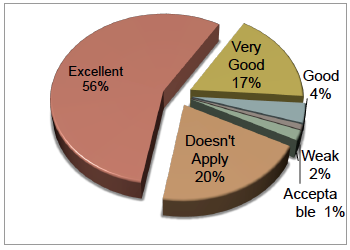
Amal – Amman – 52 years
Amal watched as her children grew up and had their own careers and lives. With the passing of her husband and her children’s busyness, her loneliness increased. Joining the Self-Empowerment training, she was able to understand her children’s circumstances, as well as form new friendships with other women of the same age. They meet regularly which helped her overcome her feeling of loneliness.
Amal Says: “I seek new trainings to attaend to further develop my character and benefit from my time.”
My relationship to my husband improved
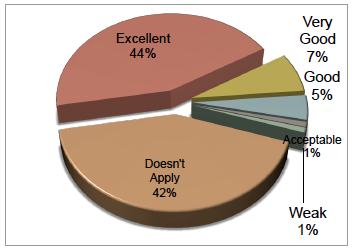 Nadia – Jerash – 34 years
Nadia – Jerash – 34 years
Nadia heard of the training that would be offered at the association she works at. Curious about the training, she joined only to find it exceeded her expectations. She was filled with doubts about her husband and was consumed by jealousy, which caused a lot of problems between them that reflected negatively on their children who preferred to spend as much time away from the house as possible. After the training, her self-confidence increased, and she became more forgiving with her husband whenever they had a difficulty. This resulted in noticeable improvement in their relationship.
Nadia says: “I opened up my heart and talked about everything, then I went into deep sleep and felt at ease; at first I was afraid it was a passing relief, but Alhamdulillah I still feel contented.”
I improved my ability to express my feelings and thoughts to those around me
 Marwa – Amman – 30 years
Marwa – Amman – 30 years
“Mama, I don’t love you”, Omar often said to his mother as a result of his constant feeling of his mom’s bigger love for his sister, which Marwa confirmed, since she was unable to express her love to her son. After the training, she felt she was not fair towards her children, and she corrected her course when she decided to better express her feelings to her … now Omar returns from school to say to his mom: “Mom I want to hug you … I love you so much”.
I can plan for the future
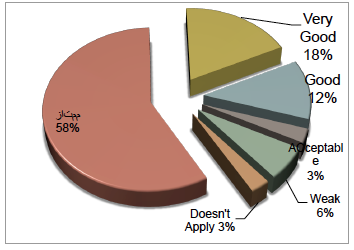 Lorda – Al-Mafraq – 33 years
Lorda – Al-Mafraq – 33 years
Lorda had neither degree nor job that enabled her to earn the money that could help her face life’s hardships. She sought employment in vain, so she thought of starting her own business, but her lack of self-confidence stood between her and her small dream.
Before enrolling in the Self-Empowerment training, she had the opportunity of joining the Emergency Employment Project, offered as part of the JRF’s Community Empowerment Program. Despite the encouragement from those around her, she was unable to join. Then she enrolled in the training that helped her create a future plan based on her participation in the project, which was the first decision she made upon finishing the training.
Kawthar
Kawthar, 41, married with three children, a girl and two boys, says “I had not choosen my life, I was forced into marriage at 17, and though I always dreamt of pursuing higher education I accepted my reality. I was abused by my husband and I was always the victim”.
She adds: “my husband was a very cruel man, but I decided to placate him so as to stay with my children. When they grew up, particularly my daughter, I insisted she studied at the university, since I had not been allowed to go”.
“I am astonished at those around us at the belittlement of the harm they cause by their hatred,” Kawthar used those words to describe the difficulty she met with her daughter who struggled to go the university, but soon malicious rumors were spread about her academic accomplishment and behavior at campus. The mother tried to dismiss such lies, according to her, until she received the news that her daughter was murdered in cold blood by fourteen bullets fired by her father in the presence of her son.
Kawthar described the sorrow of losing her only daughter whom she dreamt of seeing succeed, she said “I wished everyone would die, starting with my husband who still insults me and forces me and my children, who witnessed all the tragedies, to visit him in jail. I felt despair and lost any hope or desire to live. I was sentencing myself to death while I was alive”.
Hearing about training in a nearby association, she decided to join, which was a turning point in her life. Kawthar described her experience saying: “this is the first time I find people who listen, first time I share my story with strangers, but with them I felt that I have a home and a family for the first time. I found all the support in their truthful eyes. Through the training, I gained self-confidence, strong will, love and willingness to change. I promised myself that I alone shall make any decisions related to my life.”
Today, Kawthar is a mature strong woman; she says “I first decided to get a divorce; I shall never be a victim of his temper and violence. As for my children, I shall try to raise them to be kind and loving and eager to succeed”.
“Now I am content, and I am sure that God sent me this training to cure my past suffering and to bring hope for a hopeful future”.
Deya’
Deya’ is a 20-year old who did not finish her graduate education … she was a third grader when she underwent severe trauma after being sexually molested by one of her relatives who regularly visited her family’s house. Deya’ felt afraid, and she had been nervous when dealing with her mother and siblings, she was extremely sensitive regardless of the situation.
To deal with her negative feelings, she resorted to watching movies and TV series that took her to a prettier virtual world, especially after failing her high school final exams.
Later she started hurting herself in different ways as a way to handle her negative emotions. She started to consider committing suicide.
One of her friends was able to convince her to attend Self-Empowerment training. Having nothing else to do, she attended, only to start a new chapter in her life. Her fears and negativity that grew up with her started to fade; she began to seek new ways to distinguish herself. She became an active volunteer in the association located near her house. Through committing herself to prayers and worship, she was able to connect with God.
“For the first time in my life I express myself, I never felt that anyone would care to listen to my problems. I journal now to express myself on paper if there is no one to talk to … I feel I’m a new person!”
5. Conclusions
Self-Empowerment is part of the development system; as a concept, it promotes that a woman becomes conscious and aware of how she can draw the lines for her future, and walk her own path, which gives her self-confidence and accountability, and endows her with the tools that can help her on her path, including literacy, vocation, knowledge and ethics.
The Self-Empowerment training offers women support through teaching them the practical skills that improve the quality of their lives, therefore it brings support to their families and communities. The training aims at enhancing a woman’s self-awareness, empowering her on different levels so she can face her problems, and voice her feelings, engage deeply with others, in addition to empowering her to discover her inner world and personal identity, through reinforcing a number of concepts related to emotions, body and relationships, and defining the interests relative to the concepts of money, sex, employment and spiritual values.
The Self-Empowerment training, called the Empowerment Workshop, was implemented by the Jordan River Foundation in cooperation with the USA-based Empowerment Institute.
- A large group of beneficiaries was enthusiastic about this training, as it gave them the tools to handle different challenges and concerns they had faced before the training.
- A group of respondents emphasized the lasting effect of the training, which they felt a year or more after they participated.
- The participants emphasized the development of self-confidence and self-care as key impacts.
- The training enhanced the interaction between the Jordanians and the Syrian refugees.
- The training had a positive effect on the trainees’ immediate community as they shared what they had learned widely.
6. Recommendations
- Since the IMAGINE Empowerment Workshop proved to be highly effective it needs to be rolled out widely throughout JRF for its own direct benefits and to increase the impact of JRF’s other programs.
- JRF needs to seek the necessary funding for the rolling out of this training and provide the logistics support necessary to hold it.
- Follow-up and post-training support activities need to be conducted to maximize the impacts the training has on its attendees.
- Success stories about training participants who benefited from the training and showed clear impacts in their lives need to be carefully recorded to use as inspiration to others.
View and/or download the PDF of Jordan River Foundation: IMAGINE Empowerment Workshop Evaluation Results.
IMAGINE Program Launch 2010
